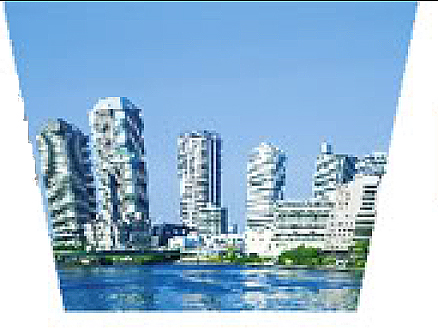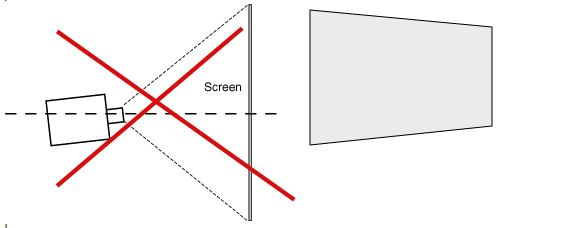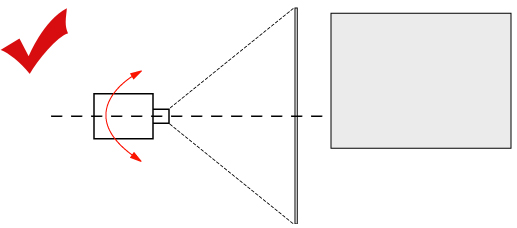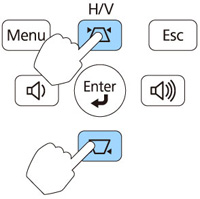Correcting distorted projector images
 You’ve set up your projector but your image is distorted.
You’ve set up your projector but your image is distorted.
Learn how to counter the keystone effect.
In order to display the correct picture, your projector must be properly aligned with the screen. If there isn’t the proper perpendicular alignment, the projector image will look like a trapezoid rather than a square.
The keystone effect can be frustrating for both the presenter and viewers. It’s distracting to have an off-angled projector image and may make your presentation look unprofessional.
How to correct
 The old school approach was to prop up the projector with books or furniture to correct the angle for a proper projector image. Today’s current projectors are a bit more sophisticated but the principal remains the same: Correct the angle.
The old school approach was to prop up the projector with books or furniture to correct the angle for a proper projector image. Today’s current projectors are a bit more sophisticated but the principal remains the same: Correct the angle.
You can correct keystone problems either manually or using the keystone correction, a feature that most 1080p projectors now carry.
Manual correction
 Physically adjusting the lens so the projectors is at either a higher or lower angle that it was on a flat surface can often solve the keystone problem. Try tilting the projector up so the projector image is higher on the screen or moving it further away from the screen. If the projector is mounted on the ceiling you may have to add an extension to the mount that allows you to lower the projector. Manual adjustment is the best way to correct keystone problems.
Physically adjusting the lens so the projectors is at either a higher or lower angle that it was on a flat surface can often solve the keystone problem. Try tilting the projector up so the projector image is higher on the screen or moving it further away from the screen. If the projector is mounted on the ceiling you may have to add an extension to the mount that allows you to lower the projector. Manual adjustment is the best way to correct keystone problems.
Digital keystone correction
 At times you will not be able to control your presentation space, particularly if you are on the road with your projector. The new DLP projectors are equipped with digital keystone correction allowing the projector to resize the projector image so it appears square.
At times you will not be able to control your presentation space, particularly if you are on the road with your projector. The new DLP projectors are equipped with digital keystone correction allowing the projector to resize the projector image so it appears square.
Many projectors have a keystone menu button to digitally adjust the image. With other projectors you access keystone through the Picture menu and press the Up/Down arrows to adjust the projector image. The default setting will be at 50, which means no adjustment has been made.
A fixed keystone correction allows the projector to shoot upwards so tilting the projector is not necessary. Your angle for correcting the keystone will be listed on your specification sheet or in your use manual. Projectors will also vary at how much correction they can provide. Up and down (vertical keystone correction) will vary from 12 to 35 degrees of correction. Horizontal keystone adjustment is not a popular; although some of the higher end home theatre projectors are offering this feature.
Use digital keystone correction as a last resort since it involves scaling the projector image and this can create visual distortions. It doesn’t create the ideal picture quality especially with graphics and charts, which can be an important feature in business presentations.
Setting up your projector correctly is the best way to solve the keystone effect.

Hello. I ran across your website while I was researching a fault I am having with a Casio projector. I am a service technician, and have been working on projectors for a long time (15+ years). I am authorized and trained by Viewsonic and Epson, so I have a reasonable knowledge about what I am doing.
The projector is a Casio XJ-S10 DLP. It came in with fault in the optical engine. This projector has powered focus and zoom, but would not focus. When inspecting the optical engine, I found one of the tabs on one of the movable lenses was broken off. Since the engine is so expensive, and not economical to replace, I used epoxy to secure the broken tab. It worked quite well, as the lens now has full motion.
Here is the problem. After reassembling and testing, using a computer VGA port (I use this on all the projectors I work on, and it has never failed to work correctly) I have found that the system EDID will detect the projector and set the resolution to 1080. However, it not only seems to be interlaced, but the colour is green, almost like a colour is missing, but all the colours are present. The menus look fine. So, I have a flickering image that’s a washed out green colour. If I change the resolution to 1280 x 1024 or any assorted other resolutions, the picture is perfect. I have checked the specifications for this projector and it says it supports 1080p. Since I have never worked on this model before, and I cannot find any information on the ‘net regarding this issue, I don’t know if this is a problem with this particular projector, of if it is a common issue with all of these model of projectors. Please note that the projector only has a VGA port, no HDMI or other video port types. I have never seen an fault quite like this. I will check back here over the next few days. I really hope you might have an idea I can follow up on as I am pretty much out of ideas. If you can’t help, well thanks for you time anyway.
Hi John,
This problem is a bit too technical for me to answer. I’ve sent it to my forum expert who will check it out. Have you joined our forum? This is the kind of post that our experts love to dive into and solve. You can join the forum at
http://www.fixyourdlp.com/forum/
Cheers,
Shelagh
My artograph projector is turning all images to square. They need be rectangles. I have adjuste with Adobe photosg\hop to no avail
Hi Ron,
This video explains how the grid works and how to change the images
https://www.artograph.com/projectors/led1000info/led-1000-quickstart-step-5/
For you to adjust from square to retangle:
Select “Grid” on the remote; press left or right arrows to select desired grid and grid color
based on the projected surface
The grids may be projected alone as a template to aid in alignment and as a guide when painting, drawing or lettering. The grids can also be superimposed over an image to aid in alignment and composing. Load image from digital source. Push the “Grid” button on remote to select or change grids and color.
Hope this helps.
Rehards,
Shelsgh